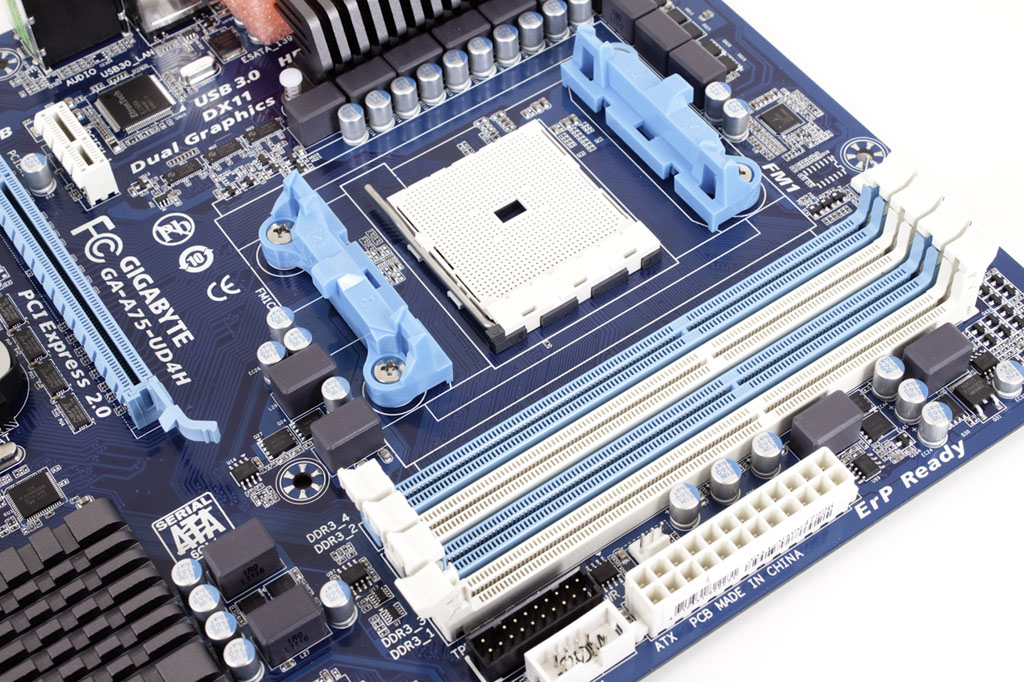BIOS -
BIOS is an acronym that stands for Basic Input/Output System. It is meant to control your product at a very low level. As of right now there are three regularly used BIOS formats (there are actually more than that but there are three common ones). These are the AMI (American Megatrends Incorporated), Award, and Phoenix. The Gigabyte A75-UD4H falls back to the old style of BIOSes. Instead of the newer UEFI (Unified Extensible Firmware Interface) you get the traditional blue and white “plain text” flavor of BIOS. It is still more than functional, but it does not have the same flare that the newer BIOSes do.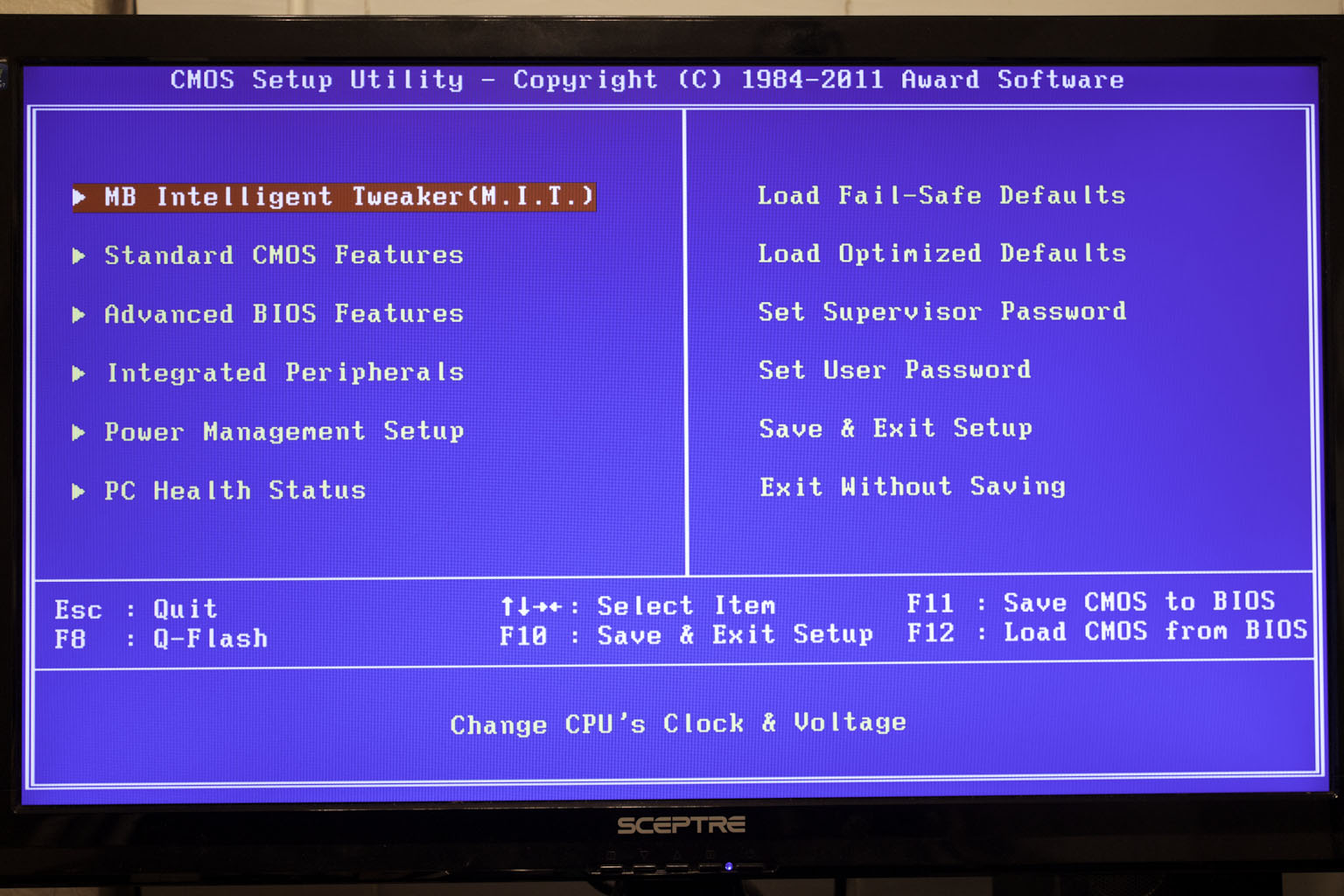
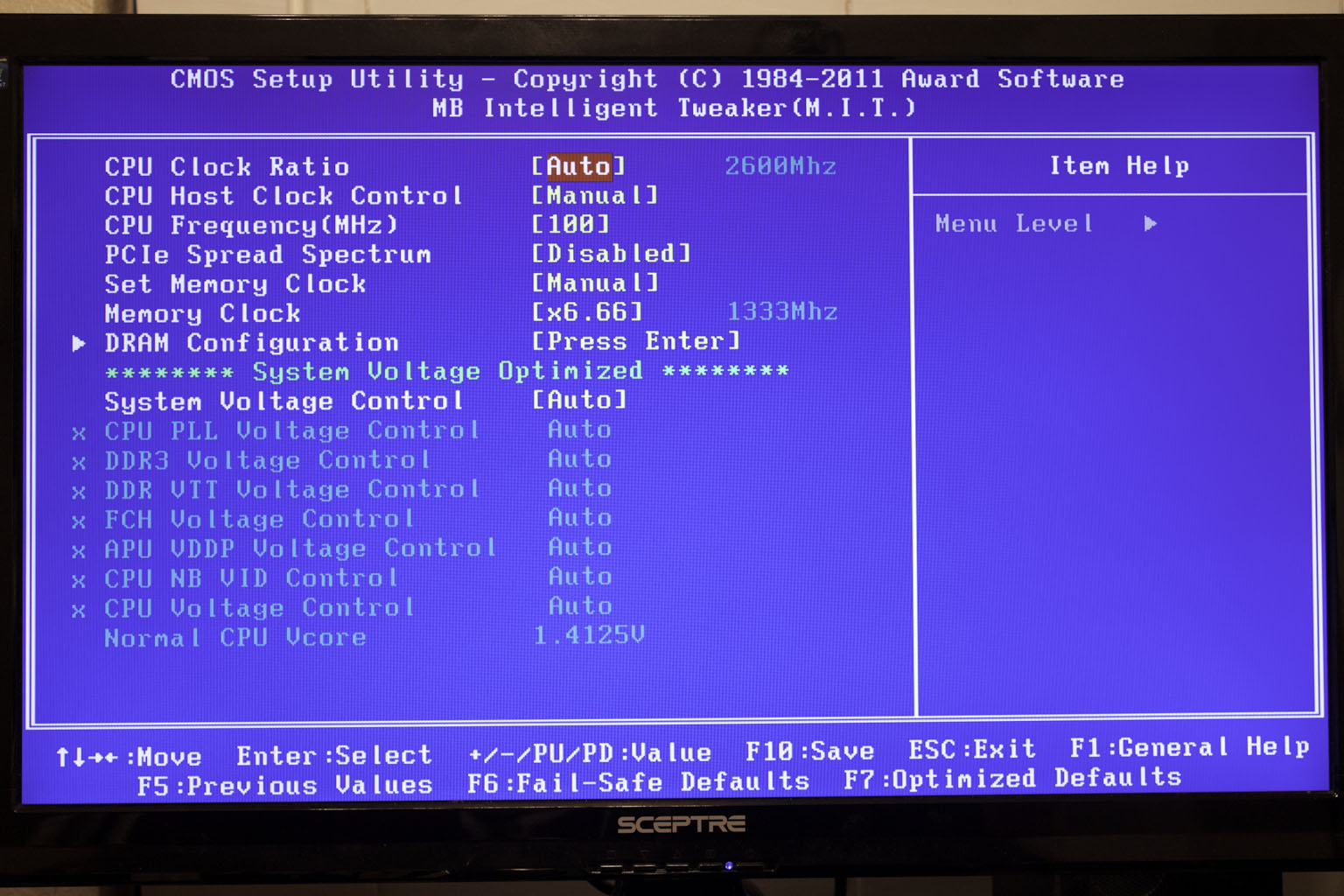 |
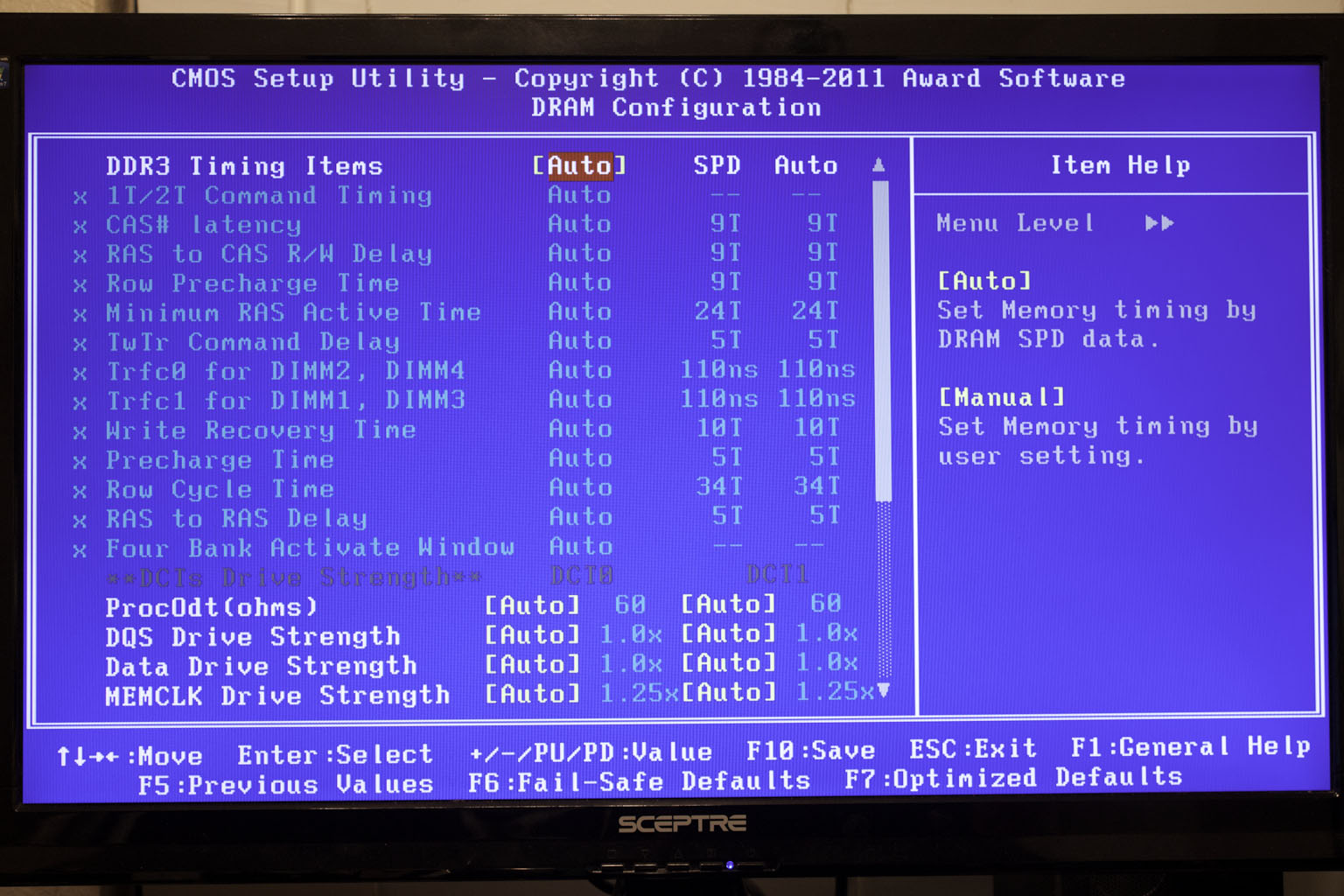 |
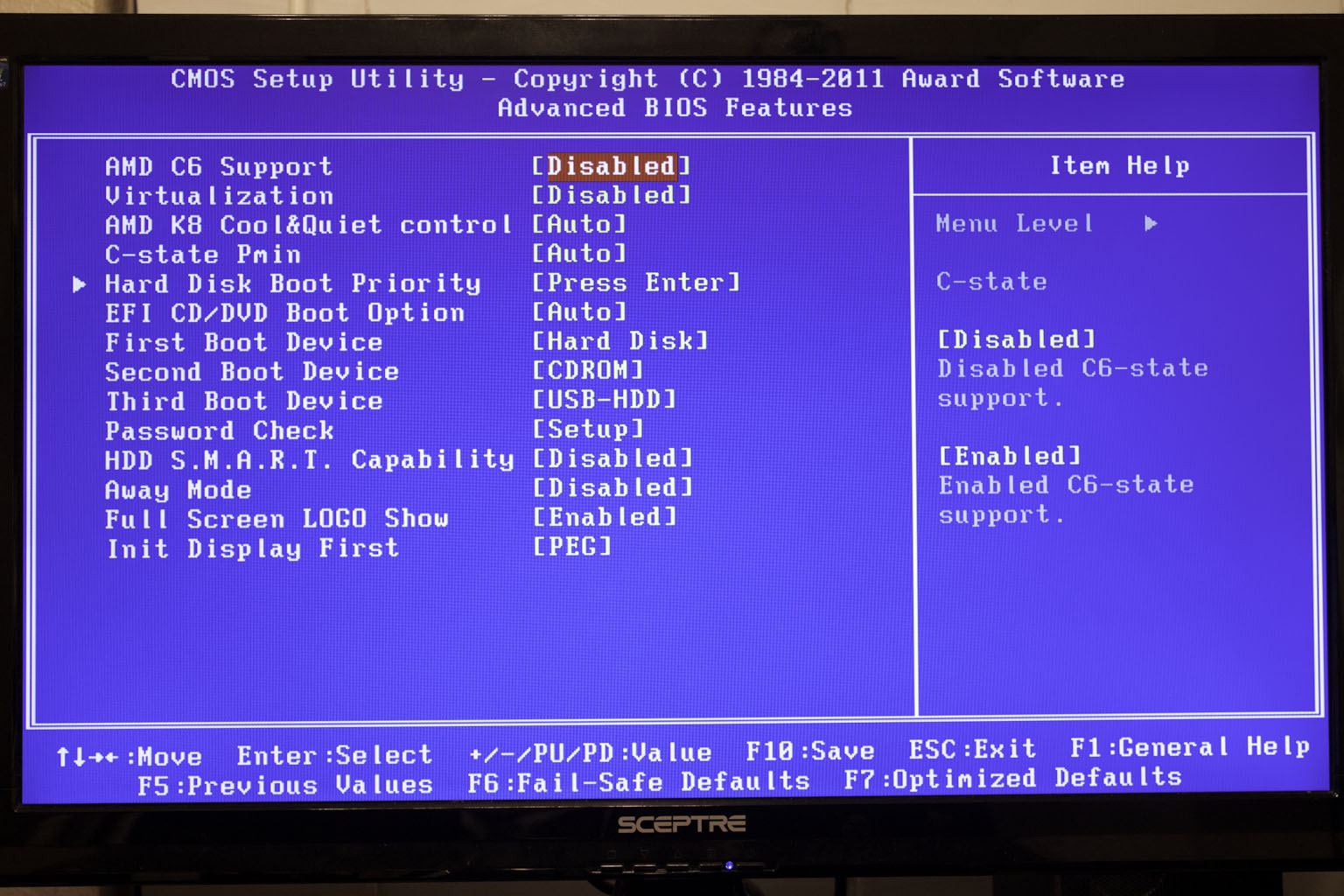 |
As you can see the BIOS layout is pretty much what you would expect from a Gigabyte motherboard.
There is not much new to talk about from this end, but we will cover some of the highlights. As usual the M.I.T. pages are well laid out and keep to the clean and simple.
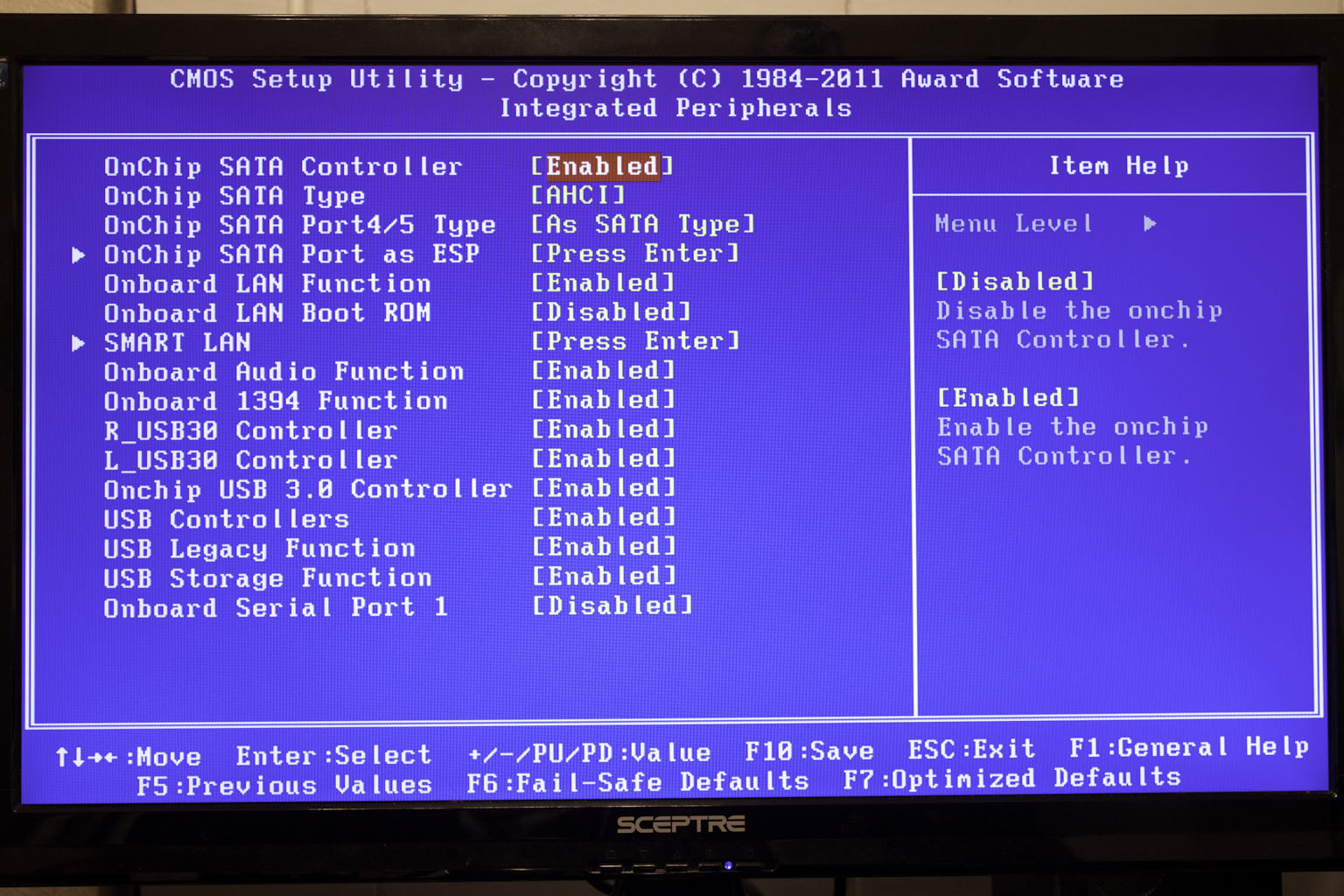 |
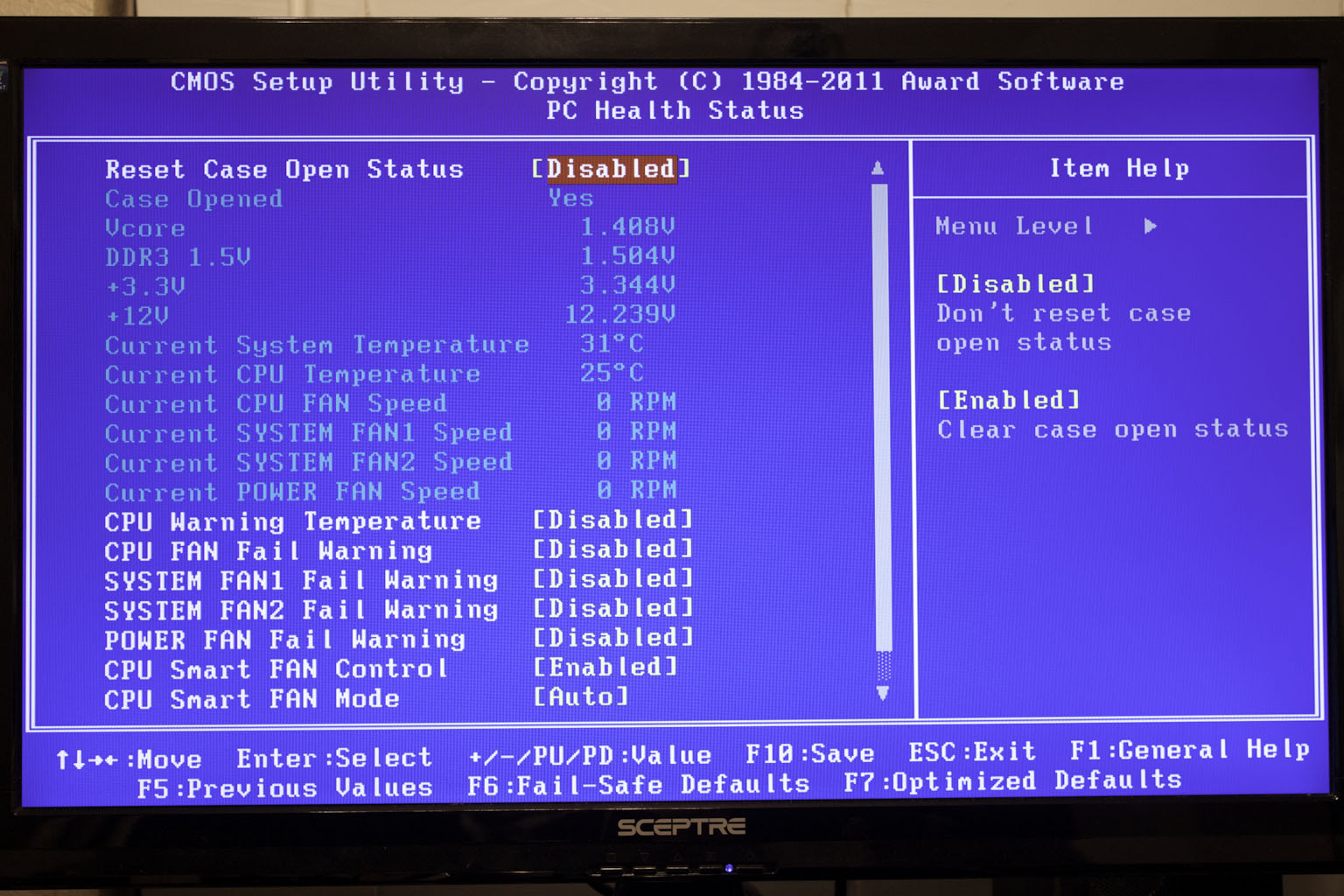 |
The rest of the BIOS falls into familiar categories like the Advanced BIOS features, Integrated Peripherals, etc. There really is not much to talk about here.
Overclocking -
The AMD Liano CPU was not the easiest to overclock. It took some trial and error to find the speed where we could run all of our application without crashing. In the end we did find one item that was affected by our overclock no matter what the speed. This was the USB 3.0 controller. Interestingly enough we had issues with the USB 3.0 controller on the Intel X79SI motherboard. The most interesting thing is that they are all different brands. The Intel board was using a Renesas Controller while the Gigabyte A75 has both an AMD controller and an Etron. All of these are supposed to be based off of the original NEC design and specification, but we have been noticing more than a few issues with non-NEC controllers. Getting back to the actual overclocking, we found that we were able to crank up our 3650 CPU to 3.240GHz (270MHzX24). Unfortunately ALL of our AMD CPUz validations get rejected these days and we still have not been able to find a good answer for why this is happening.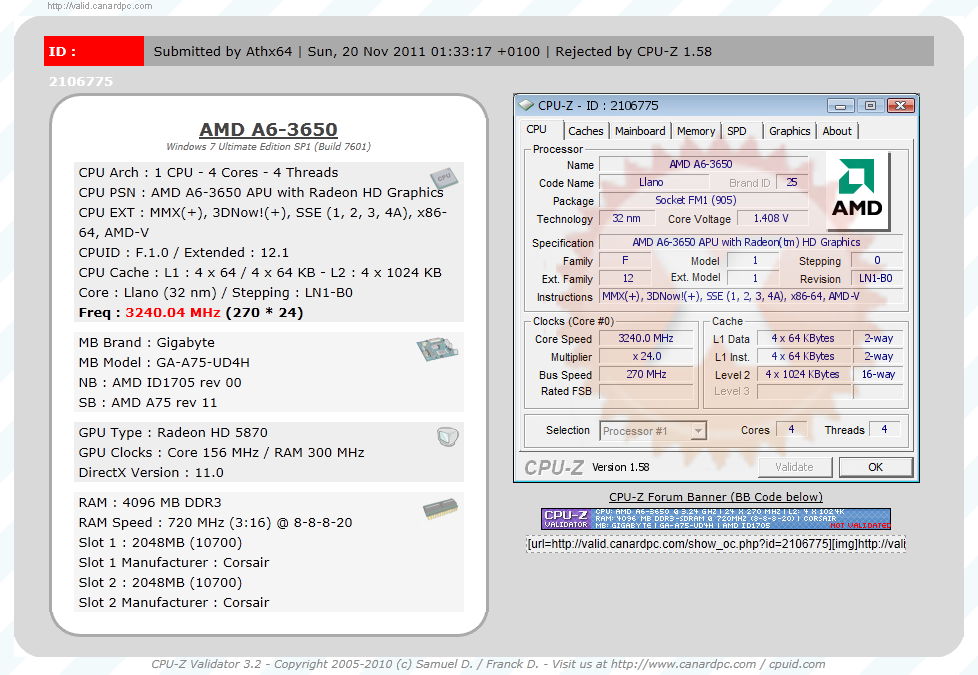
Of course overclocking is a picky subject. I can buy to identical CPUs from the store and they will not always perform the same way under stress. This is the same with motherboards, RAM and GPUs. So again it is important to keep in mind that our results represent a specific hardware configuration. Yours may be similar but will rarely be identical.
Overclocking Tools -
Gigabyte’s tools of choice is EasyTune6. This is a suite of tools that are combined in a single UI. I have to say that in my opinion the UI is a little boring and there are pages that get in the way of what it is intended to do. However, this does not take away from the functionality or the performance; this is just a personal thing. The first two pages get you the same information as you find get from CPUz. It is not until the third page (well really the first page when you open the application) that you get into the real workings of EasyTune6. 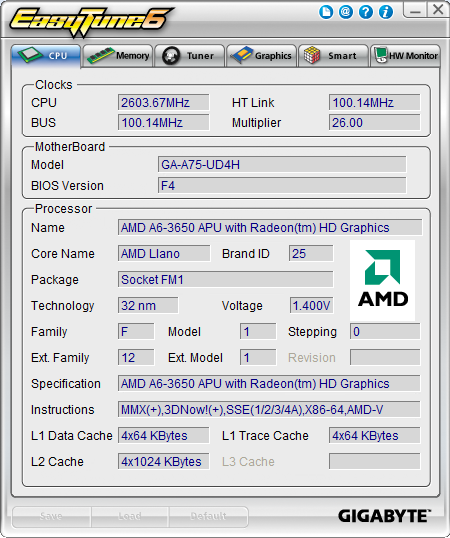
The third page in is the Tuner Page. You start off on the Quick Boost page. Here you have three options for a one stop overclock. The first two are probably places that you won’t want to go if you bought this board and the third; well that is just a pit stop on the way to higher speeds.
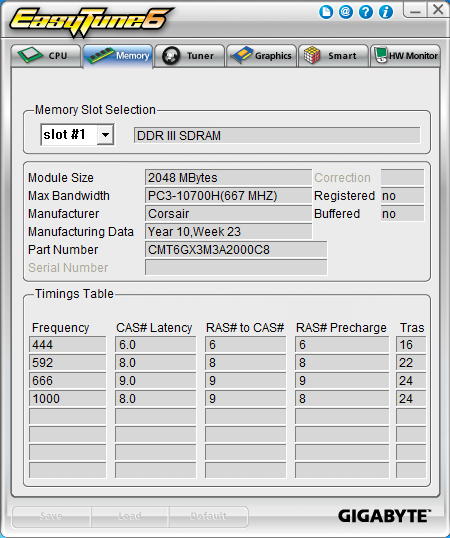 |
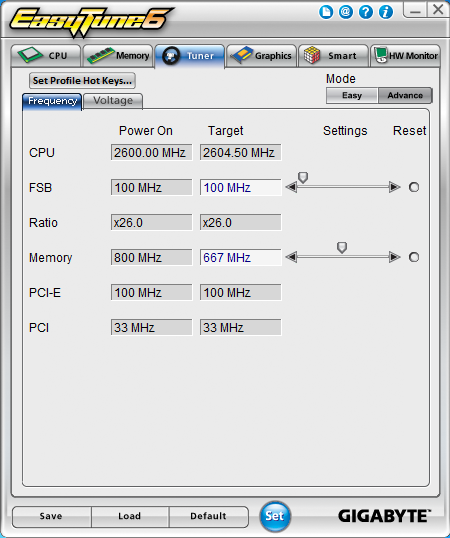 |
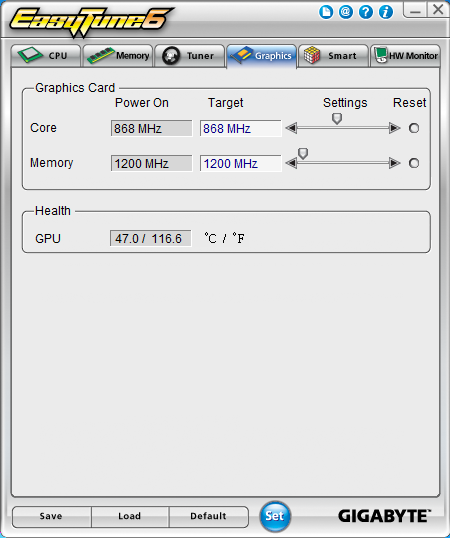 |
For the people that really bought this board for what it is intended you will want to skip over the “easy” button and head right on into the advanced settings pages. Usually you can really do some damage here, but for some reason on the A75-UD4H things are more limited. You have access to the FSB and Memory, but not to PCIe frequencies. Ratios are also locked here for some reason. The next three tabs let you OC the GPU (well most of them), setup and work with the Smart Fan settings, and monitor the temperatures and voltages. I have honestly never used the GPU overclocking function but I have tinkered with the smart fans and the H/W monitor.
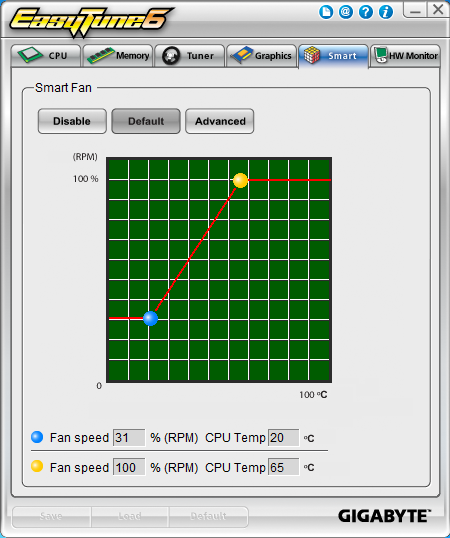 |
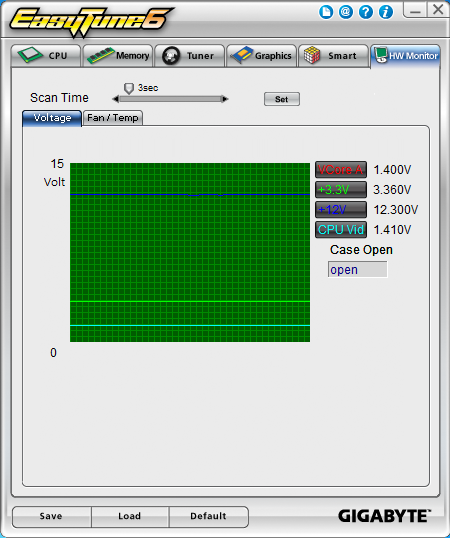 |
The Test System and Comments -
Our test system is built on an open bench. This has two effects on testing. First it allows us to see everything and also to setup and disassemble the test rigs quickly. Second it means that we cannot gauge the potential air flow found in a normal case. The air is pretty stagnant; some may say this is a great neutral testing method and it can be. However, it does mean that the temperature reading taken off of the components are not accurate to what an average consumer would see. This means that your thermal performance will vary from what we see here.
The Gigabyte A75-UD4H was an easy board to setup and get running. Then again, many boards are easy these days. The only real issue we had was with the USB 3.0 controllers and our overclocking tests. Other than that things were very smooth.
Usually we only talk about the installation and setup during this section but we are going to change some of that staring with this review. As we tend to test things a little longer (and in some cases more thoroughly) we wanted to talk some about the overall experience. The first thing that we noticed was that the A75-UD4H when combined with the 3650 CPU from AMD felt quick and responsive for most tasks. We did not have any speed issues when running common tasks like browsing the web or even some light productivity work with applications like Office 2010.
In other words, the A75-UD4H “feels” like a very quick product. To the average consumer (and to some prosumers) this board would be excellent for day to day tasks and some light productivity work. Now let’s see if the numbers back up our impressions…
Performance testing overview -
Our testing is a little different than most. We combine both synthetic and real-world applications to simulate the types of performance common to the individual products. For motherboards this means that we run roughly six synthetic tests and two real-world. We will be expanding the real-world testing in the near future. But there is more to performance than just the raw numbers. As there are multiple components and sub-components on a motherboard there each item can have a distinct impact on the way the product will perform once you get it in your system. It is important to note not only the actual results but what they mean to you as a potential consumer. We will try to give this information to you. But we do not just cover the performance aspects that are measurable. We also talk about the components that might not have a direct benchmark. These are items like Audio Quality, ease of use and installation.
Section 1 Subsystems
Memory -
Memory performance is very important on a motherboard, especially when you have a CPU with multiple cores and threads. If you have slow memory your cores and threads can become starved for data to execute. To test memory performance we run both Sisoft’s SANDRA and AIDA64. These two combine to not only give us accurate numbers but to validate each other. For testing at stock speeds the memory is hard set to 1600MHz while overclocking testing is done at the highest stable speed for the voltage of 1.65v this is due to the different memory dividers for each CPU. As such, the memory speeds will vary greatly. This means that the overclocked numbers are a little misleading and while they can show a trend are really only included to show if a board has a problem with memory performance at high clock speeds.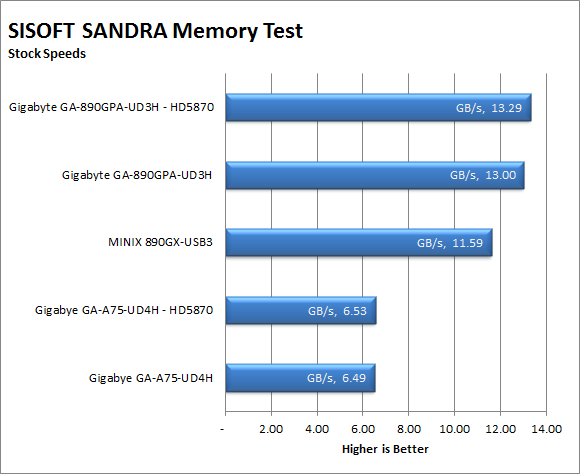
Hmmm, the memory performance here is quite a bit slower than the perceived performance would have hinted at. With Single digit memory bandwidth numbers we would have expected applications to crawl especially when we opened multiple windows. However, this was not the case. I would still be a little concerned about running any memory intensive application on this board though.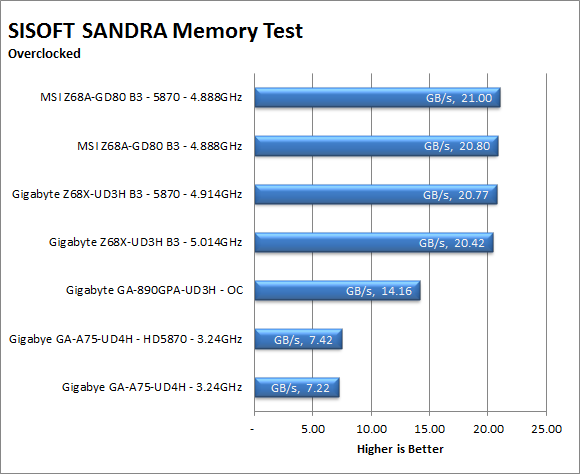
The AIDA64 numbers tell the rest of the story. The IMC on the Llano just does not have the same potential bandwidth as other more mainstream CPUs. It does more than keep up when compared to CPUs like the Atom though.
| AIDA64 Stock Speeds | AIDA64 Overclocked |
 |
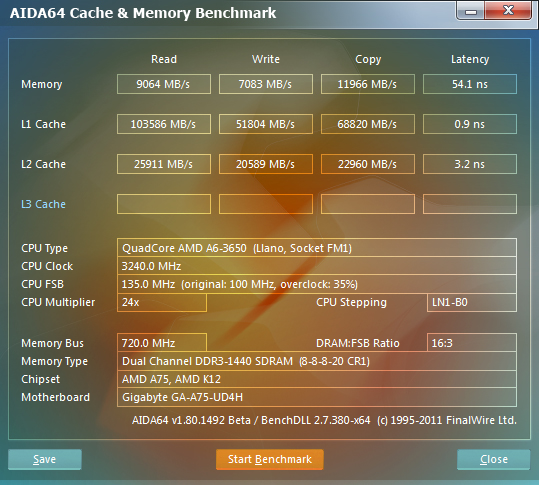 |
Drive performance -
Drive performance is also one of the major subsystems that goes to make up the performance of a motherboard. For our testing we use Sandra and AIDA64 again. We only test with single drives for each type of controller present on the motherboard (unless it is a professional product where we will use RIAD 5 and/or 10). We have also begun using a Seagate PS-110 USB 3 external HDD for our USB 3.0 performance. As a side note, we include the overclocked numbers here to make sure (again) that you are not going to see a major drop in performance due to minor instabilities at high clock speeds.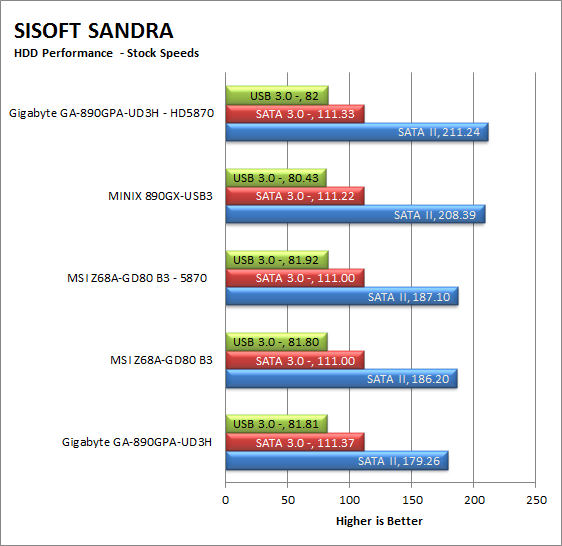
HDD speeds were right on par with the rest of the competition. We would expect to see good installation times and also application load times with this type of performance (unless the installer loads entirely to memory…). 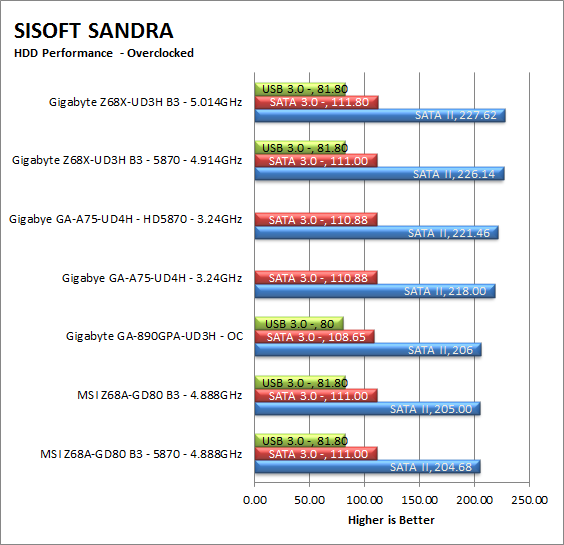
| AIDA64 HDD Performance Stock | AIDA64 HDD Performance Overclocked |
 |
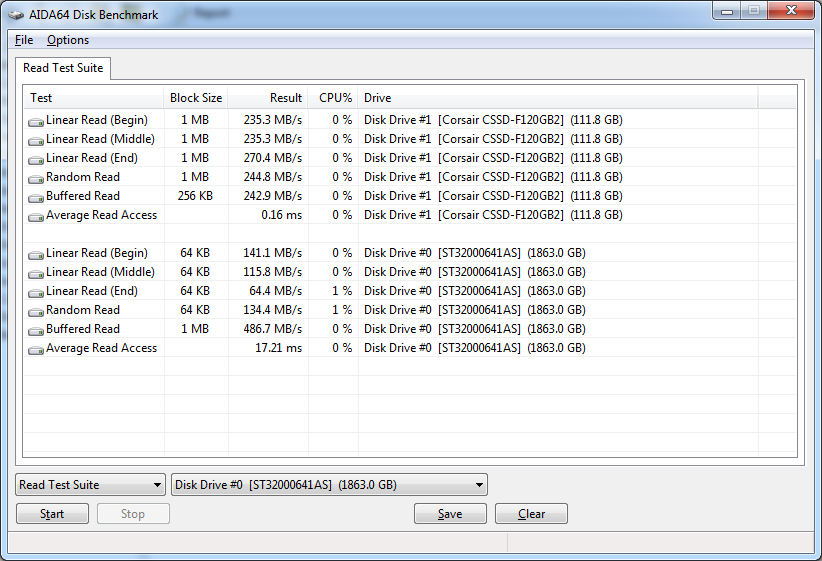 |
Power -
Power efficiency is another of those misnomers that we get caught up in. We hear about idle states and power gates. But what does that mean to you and I? On the surface having power management that reduces idle power sounds great and can be a benefit to someone that leaves their system on for long periods of time (and inactive) but how a system handles power under load and the delta between the two states is often more important than the idle power usage numbers. We use only P3 Kill A Watt instruments for measuring power. 
As you might expect the power draw on the A75 was not that high. In fact we found that at idle the average power was almost half of some of the other boards in our test group. With this type of idle power draw this would make a great “always-on” system like and HTPC or DVR for surveillance cameras. It is not going to push your power bill over the top but will still have enough power to do what you need it to.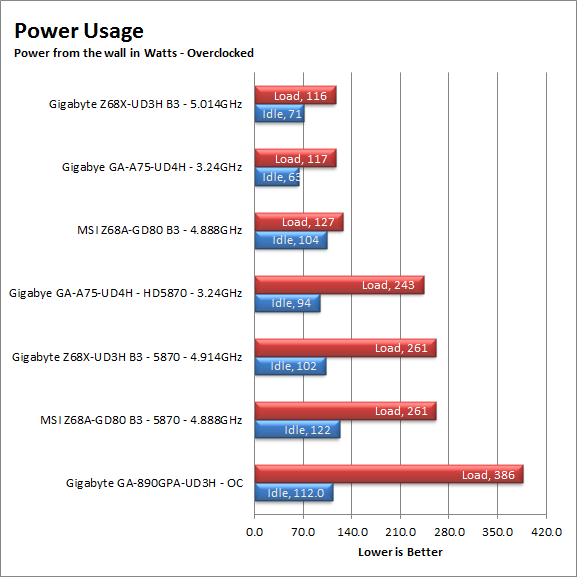
Cooling (Board Level) -
Board level cooling is an important factor in product performance and longevity. Components like the chipset, VRM modules and even capacitors need to be kept relatively cool to prevent failure. As these parts are made of silicon, they have a thermal breakdown threshold; or melting point. At that temperature the actual transistors built into chip will begin to deform and break down. Granted, the threshold is often very high, but you still need to make sure that components stay away from this level of heat for longer product life. 
The cooling on the A75-UD4H was not as good as I would have hoped. In comparison it is cooler than the AMD 890FX boards we tested but not quite as cool as many of the Intel Z68 boards in the group. 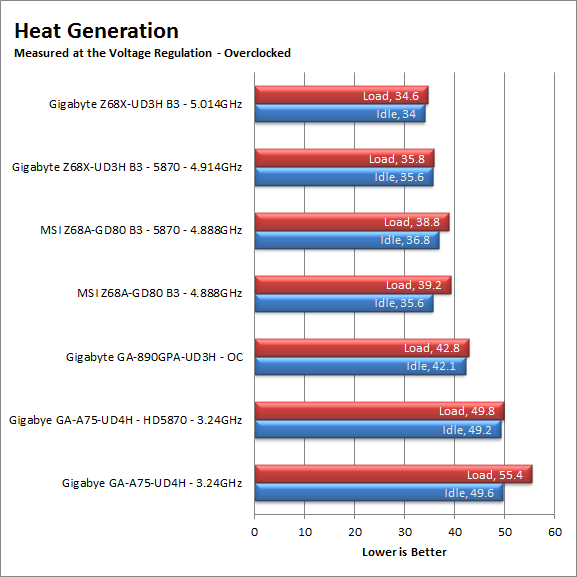
Audio -
Audio is highly subjective. What we find pleasing may sound “off” to you. That is always going to the problem with testing audio; results will vary too widely depending on the tastes of the listener. However, there are ways of measuring the audio output with an objective ear. There is also the issue of audio causing performance issues in gaming and video playback. The reason this is a potential source of concern is that all onboard audio CODECs (Compression/Decompression) are CPU controlled. This means that while the audio chip controls the audio levels and effects of the audio the actual work is done on the CPU. Usually this will not be a problem with today’s powerful CPUs. Even the lower and consumer level products can handle high-end audio these days. But again there is the chance that a bad design or software will hinder your system and performance. On the other side the limits of board space, cost, etc will also prevent the level of audio quality you can get from an add-in board. We test all audio parts with three media types, Movie (DVD), MP3 Music, and Gaming. These are pushed to our Tec On model 55 Tube Amp to see if we can detect any signal issues in the reproduction.
Gigabyte is advertising “Super Audio” on this board. For you and me that means the Audio CODEC is able render audio at a 108db Signal to Noise Ratio. This puts it right in the realm of “HD” quality audio. Now for many this is just numbers again, so we will put it plainly (and VERY simply). For every decibel of noise that the audio processor generates you get 108db of audio output. Considering that most people will never listen to their audio at that volume you are not going to get any recognizable noise from this Audio Codec. This again makes the A75-UD4H very suitable for an HTPC system, especially if you combine this with the right speakers and other hardware.
Networking -
This one is something that is a requirement anymore. If you have a computer, the chances are good (like 99%) that you are also connected to high-speed internet. With this you need a good and solid LAN chip to make sure that your data flows properly out and back.
The networking performance was also very solid. Again you are not going to win any speed awards, but you can certainly get your data back and forth across the network and the internet. Then again, when you consider than even the fastest residential internet connection right now is not over 100MB/s you do have plenty of headroom to play around with.
Section II - Performance Tests, Synthetic
In this section of testing we cover the synthetics. These are tests that run a scripted sequence of internal APIs or that use another installed application to perform a series of scripted events. They are great in that they can provide reproducible results across various platforms. On the down side, synthetic tests can be fooled with driver tweaks and optimizations. In some cases it is necessary to rename the .exe file to something generic to discover if this is the case. In any event when this is needed (when a test shows a drastic difference in performance over the renamed exe) we will note this and show both results for comparison.
PCMark Vantage -
PCMark Vantage is a suite of tests designed to test the power of your computer. It runs task that range from productivity to gaming (DX9 only). It is a great test to identify potential problem areas with general performance on a system. It can also show how well a single component can increase or decrease system-wide performance. We run both the x86 and x64 PCMark Suites for testing.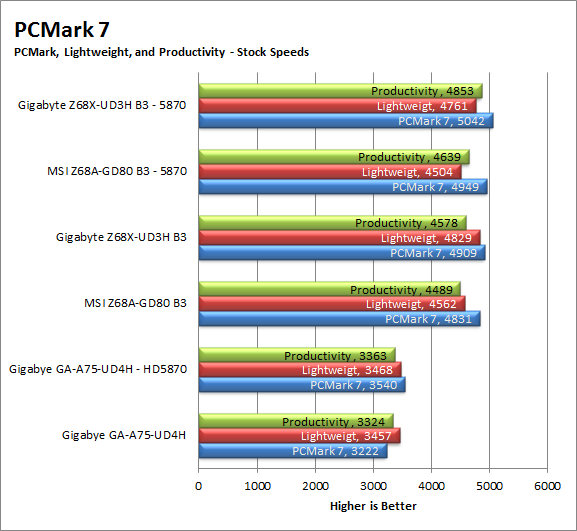
Now, the numbers here are going to put you off a bit on the A75-UD4H. That is until you take the other systems into consideration. The A75 is not that far behind Intel’s higher end CPU (Core i7 2600K) combined with the Z68 motherboard. Once you look at these in that perspective you get a better appreciation for the scores that the A75-UD4H pulled off. These numbers also confirm our suspicion that this board would be great for a general usage system.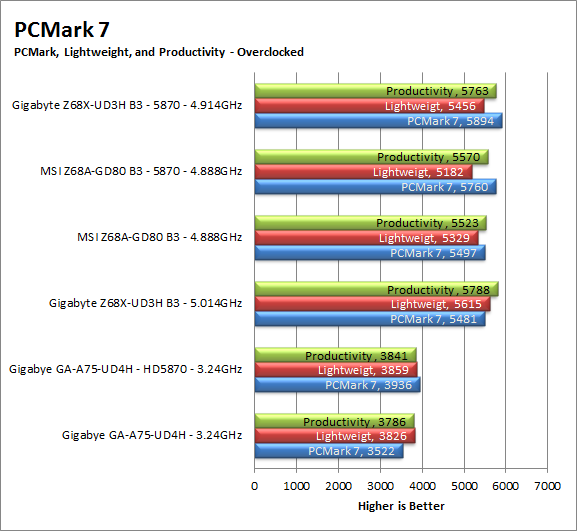
3DMark 11 -
3DMark 11 is the other Futuremark test that we run on our motherboards. This test simulates the typical tasks that a GPU (and system) would have to perform to provide you with a good gaming experience. It is based on the DX9, DX10 and DX11 engines but can only be installed on Windows Vista or later. The suite of tests covers DX9, DX10, and of course DX11 rendering; it also covers AI computations and physics. That’s right I said Physics the latest version of 3DMark uses a Havok physics engine. This removes the advantage that nVidia had with 3DMark Vantage. 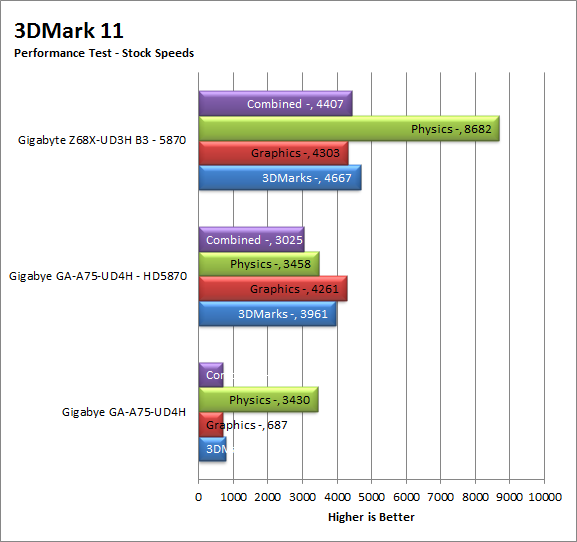
The scores here do not look so good do they? Well before you start to think poorly of the 3650 from AMD, just remember that this is the first CPU based IGP that can run DX11 completely on its own. Meanwhile Intel’s Sandy Bridge CPUs are stuck at DX10.1. You might hear that this does not matter to the market that these are being presented to, but you would not be correct. 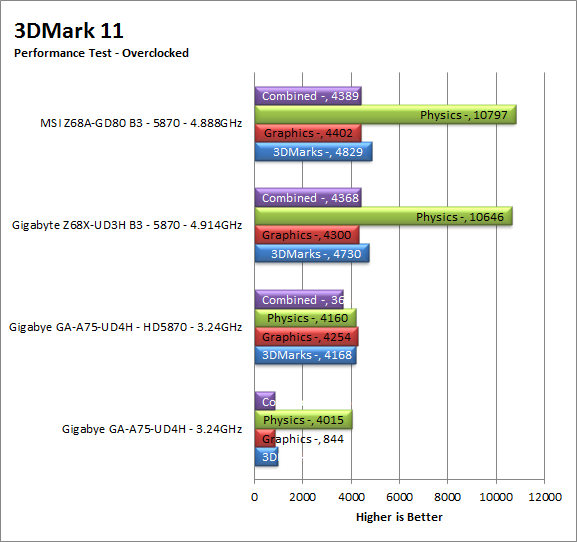
HyperPi 0.99b -
HyperPi is a front end application that allows you to easily run multiple instances of the SuperPi application. SuperPi, for those that are not familiar with it, is an application that measures the time it takes to calculate the number Pi out to as many as 32 million places. This calculation is then checked and run multiple times (up to 24 for a 32M run). This test stresses the CPU, Memory and HDD as data is handed off between the three. If there is a weak link, HyperPi will show it. For our testing we run the 32M test on as many cores (and threads) as the CPU has available. The slowest CPU time is then recorded. 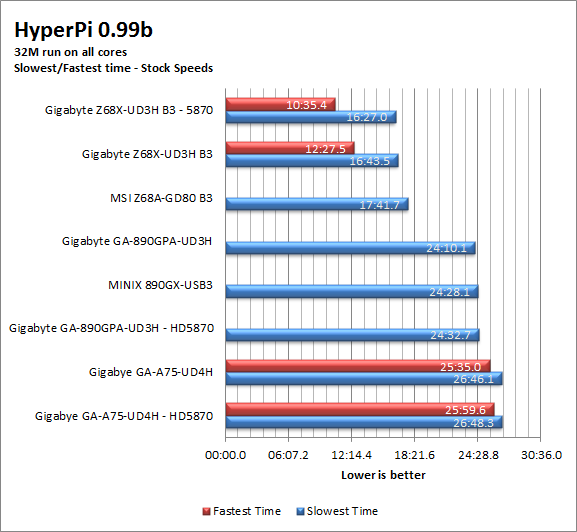
When we saw the slower memory performance numbers we knew that our HyperPi testing would be affected. Simply put, you need some very good memory bandwidth to keep the SuperPi calculations flowing. If you cannot buffer these to memory fast enough you are going to slow down dramatically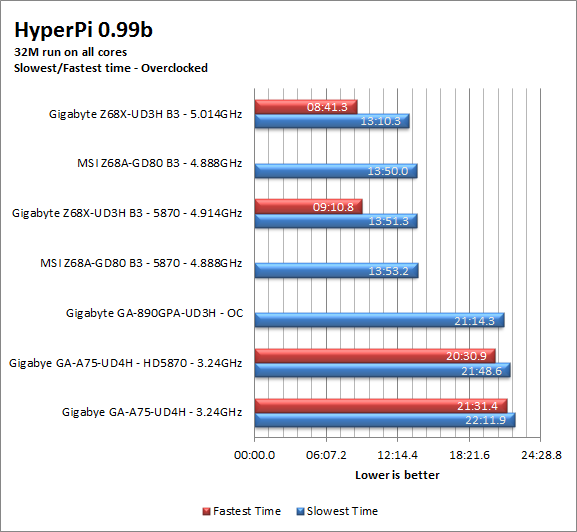
Cinebench R11.5 -
Cinebench R11.5 is the 11th release of Maxon’s rendering test. This test is based off of the Cinema 4D engine, which is one of the industry standard tools for digital animation. It is a powerful product with many different modules that can be “plugged” into it to increase its effectiveness. With Cinebench you get to see how your computer would do using this application. There are two tests; one tests the CPU’s ability to render an image across multiple cores or threads. The other tests your systems ability to handle OpenGL based rendering. 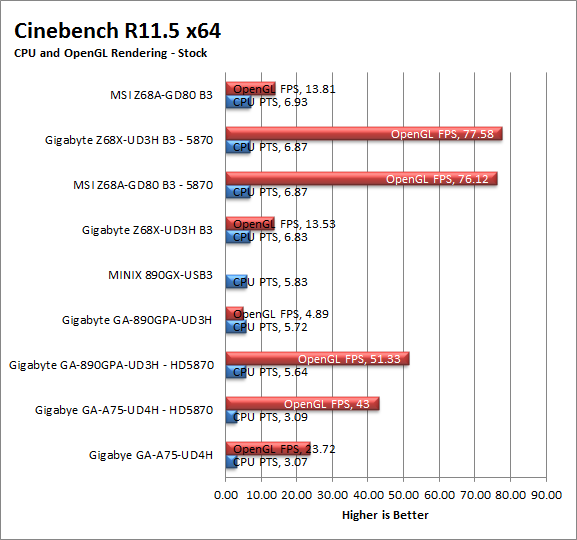
Well, we know that you will not be buying an A75/A6-3650 for rendering. The scores here are not impressive, but then again heavy content creation is not what this board and CPU combination are for.
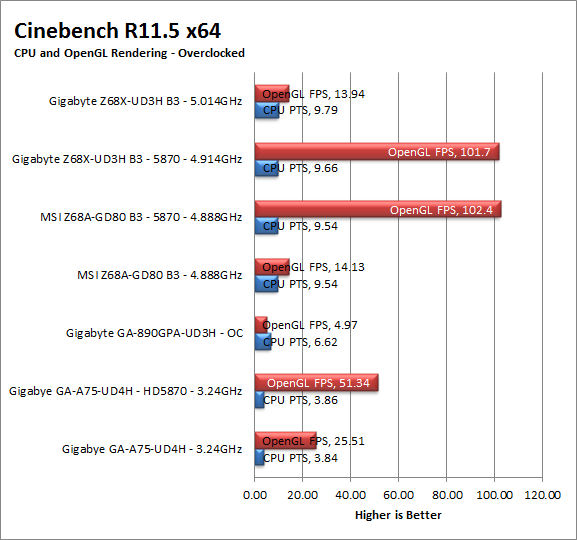
Section III - Performance Tests, Real-World
Here we have two tests that are designed to put the performance of the motherboard and its subsystems to the test. Both require good CPU, Memory, HDD and even to a lesser extent audio and network performance. The two tests we chose were Lightwave 3D 9.6 and AutoGK 2.55. We will be adding at least one more real-world test to this battery in the near future, but for now these two cover quite a bit.
Lightwave 3D 9.6 x64 -
Lightwave is another industry standard application for 3D animation and rendering. It has a large tool base and the rendering engine is highly threaded (when using the right render model). This application is also capable of expanding to 4k resolutions as well as ray tracing for rending the light sources. For our testing we use frame 470 of the Pinball scene found in the LW 9 Content folder. This uses the newer perspective camera that is better suited to a multi-CPU/Core environment. This camera style also uses ray tracing and a much improved anti-aliasing method. Settings are shown below in the attached screen shot. Of course these are single frame renders and they are not a complete picture; for that you have to take into account the number of frames an average project would have. In a typical 30 second commercial you will have around 840 to 960 frames (at 28 – 32 FPS) this means that you have to multiply the time of a single frame by that number just to get a vague idea of how long that 30 seconds would take. This is because each frame will have a different render time based on complexity.
As with the Cinebench scores, the Lightwave scores here only serve to show that you would not want to pick up the A6-3650 and A75 combination for rendering. The issue is the slow memory performance and caching. This is not a huge concern for the market that this APU/motherboard combination is for though. 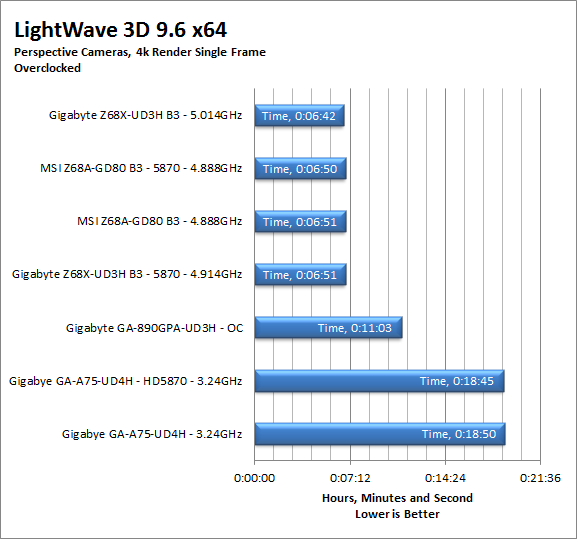
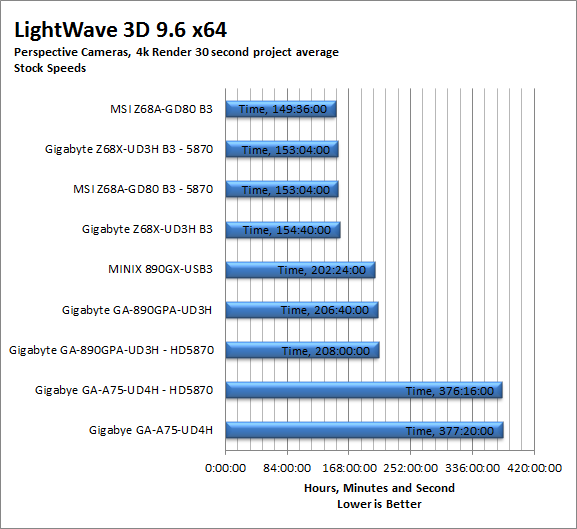
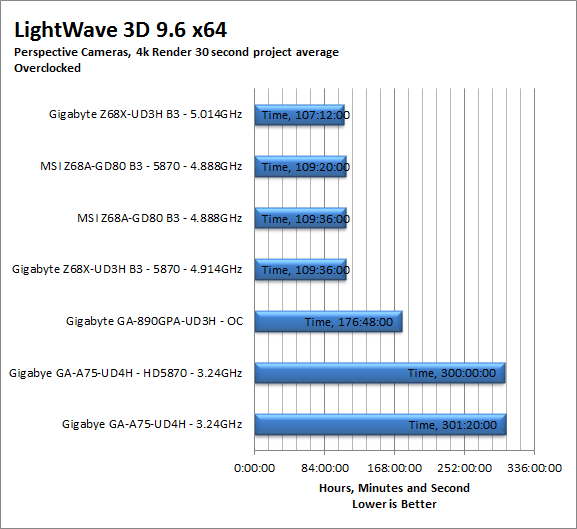
AutoGK 2.55 Transcoding -
AutoGK is a transcoding software that is really multiple parts combined to make an easy to use whole. It combines, items like FDD Show, Xvid encoder, Virtual Dub and others for use in converting one media format to another (usually Xvid AVI). It will not transcode copy protected DVDs or Bluray discs yet (you still need a decrypter for that). But it does an excellent job on everything else. For our testing we use a 2 hour movie that has been placed onto a standard definition DVD for playback; we then transcode this DVD to a 100% quality AVI with the original audio intact. This puts a strain on the CPU, Memory, HDD and the attached DVD ROM drive.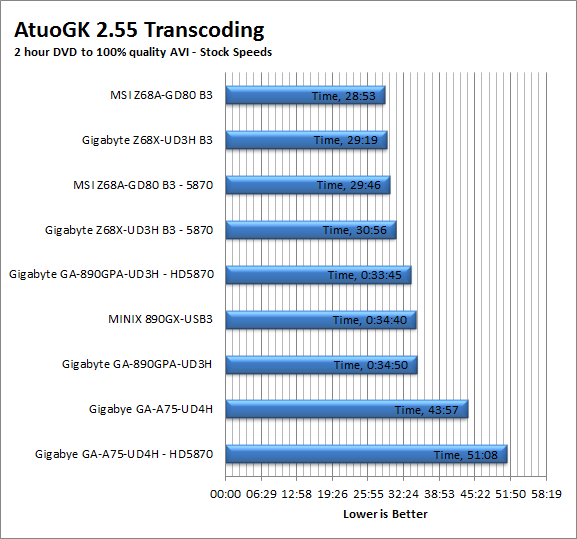
As you might have expected the A75-UD4H and A6-3650 is not that great at transcoding using AutoGK. However, we have recently discovered that while AutoGK is great at handling multiple CPU cores it is not so great at handling memory efficiently. We will be replacing this application once we are finished testing out a few on multiple platforms to make sure there are no issues (or unfair advantages). Still considering the limited memory bandwidth and caching on the A6-3650 this is not that bad. We were disappointed that our scores decreased when we dropped in the Radeon HD5870 though.
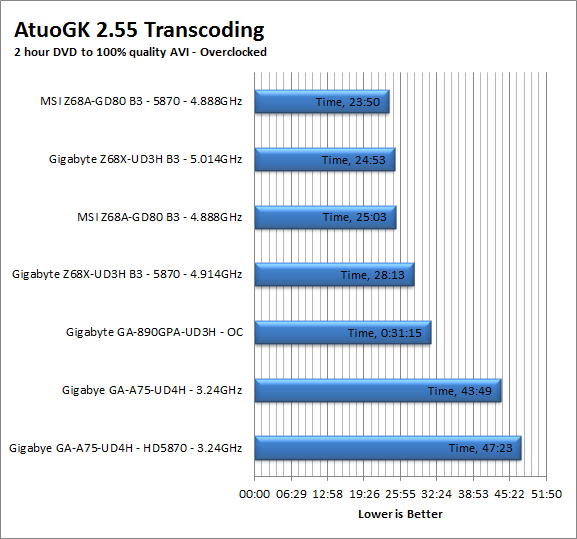
Section IV Performance – Gaming
Gaming as a test of motherboard performance is sort of a joke these days. The big player in the gaming arena is the GPU. Everyone but a few hardcore PR teams know this. However, it is important to run at least a few (one from each current DX version) to see if there are any issues with the combination of components on a motherboard. These are items like Audio lag, memory lag and of course problems with the PCIe lanes and signal traces. If there are issues in design, drivers or BIOS then you can have odd gaming performance. So without much more preamble let’s dive into the three games we currently use; Call of Duty Modern Warfare 2 for DX9 FarCry 2 for DX10 and Battlefield Bad Company 2 for DX11.
Call of Duty Modern Warfare 2 DX9 -
This is an excellent but short game that put you right into the action from the beginning and does not let up the pressure until the very end. The graphics are a little better; most notably the night and thermal imaging have been improved. The AI is still the typical COD “bar fight” style AI, with maybe a tad more finesse. All in all it is not a bad game to play and a decent one to use for testing. Our testing run starts at the bridge and ends after you clear the school in the first level of the game. Settings are shown below as are the performance numbers.
| IGP Settings | HD5870 Settings |
 |
 |
 |
 |
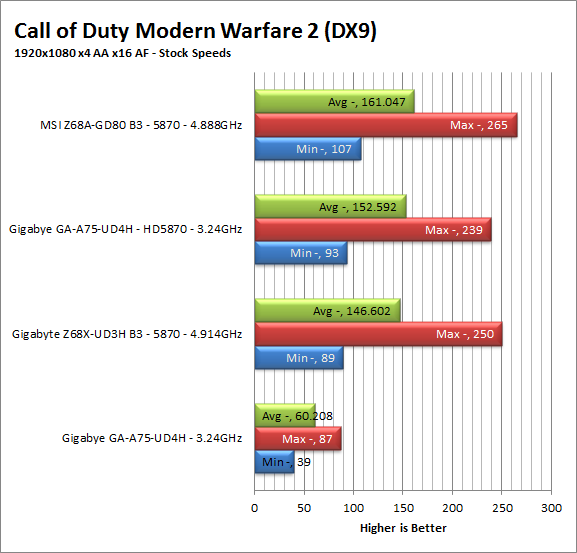
Now this is impressive. This is the first time we have seen reasonably playable frame rates from any IGP even at a reduced resolution/effects setting. At 39FPS Modern Warfare is more than playable. It is not the best visual experience, but it is still impressive to see if playing this game. 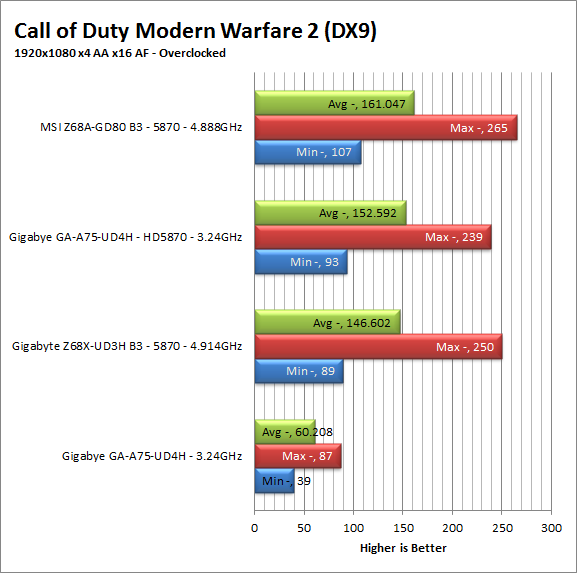
FarCry2 DX10 -
Although not one of my favorite games this tedious game does have some good graphics. The large sandbox style of the game lends to mission based play. The only problem is that the AI is rather low grade. Still the more CPU power the more the bad guys try to do. Over all the game was a little bit of a disappointment to play, but still not a bad DX10 representation. Our testing run starts right after you get your first mission to clean out the safe-house and ends after the hostage rescue. Settings and performance numbers are shown below.
| FarCry 2 Settings for IGP | FarCry 2 Settings for HD5870 |
 |
 |
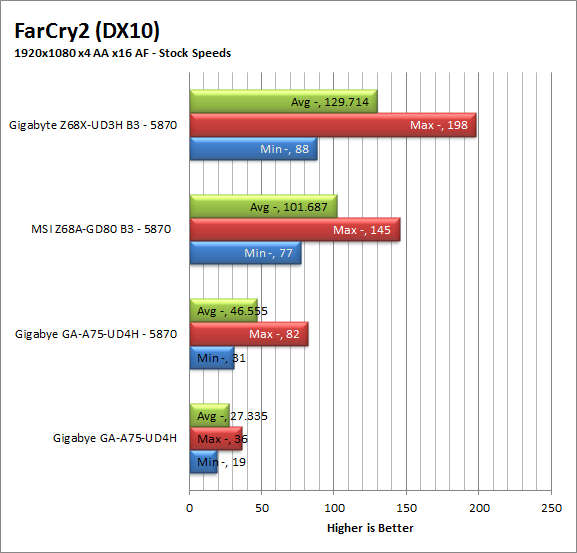
Under FarCry 2 things are a little different. As we have told you before FarCry2 is an Intel optimized game. It is meant to take advantage of the CPU and its processing power. Unfortunately the A6-3650 does not have enough horse power to make a big difference in this game. You could still play it (especially when overclocked), but it would not be that great of an experience. 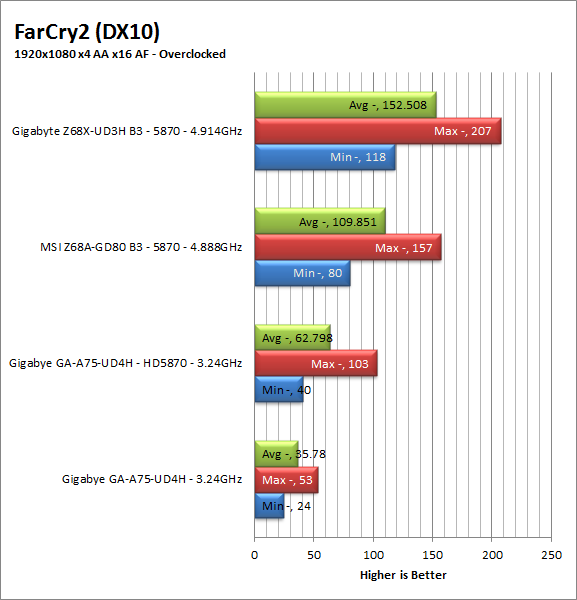
Battlefield Bad Company2 DX11 –
I have liked many of the Battlefield games. They usually tend to be fast paced and fun. With Battlefield Bad Company 2 you do get some of that, but there is something about the graphics and the movement that just does not sit right. The AI is a less sophisticated form of the bar fight AI, but it gets the job done. Still, the game is good for testing as it can put a strain on the components of the board. Out testing run is the entire first level, from beginning to end. Settings are shown below along with the raw numbers.
| Bad Company 2 IGP Settings | Bad Company 2 HD5870 Settings |
 |
 |

Here, is where the A6-3650/A75-UD4H shines. Look at the performance we are getting from just the APU in Bad Company 2. You would be able to play this DX11 game without the need to pick up an add-in GPU. Yes, it is not the full experience with all the eye candy, but it is still more than playable. You cannot get this from any of the Intel CPUs with an integrated GPU. When you do drop in the HD5870 your performance only gets better.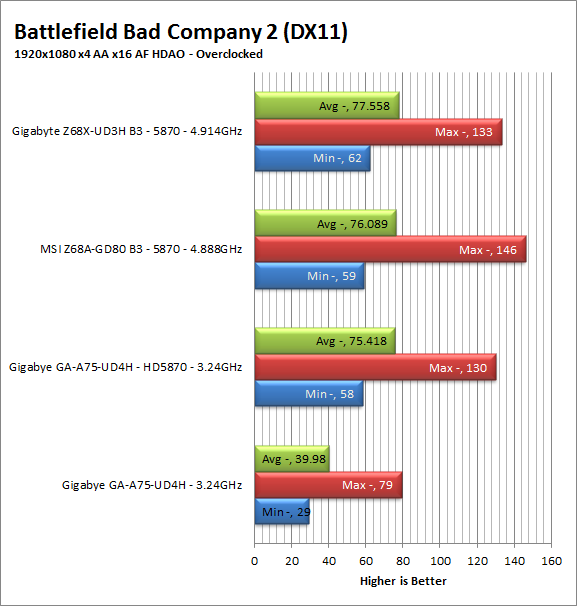
Gaming wrap-up -
The A75-UD4H and AMD A6-3650 was pretty impressive when it comes to IGP based gaming. When you consider that the games we used for testing are not low-end games the performance even looks better. This means that you can expect this APU to play games like World of Warcraft, Total War, Civilization and other turn based roleplaying games quite well. When you combine the audio and its 108db SNR the gaming experience gets even better.
Value -
Value is another very subjective topic. What is expensive to some might be a deal to others. You can look at this topic in multiple ways. One is raw price and the other is what you get for the money. Each is accurate and both are correct ways to look at price/value. We tend to look at features, performance and real-property when we discuss value. However, we also take into account the raw cash cost of the item. Gigabyte’s A75-UD4H will cost you right around $115 from most e-tailers. We were a little surprised at this price and thought that we would find it at just under the $100 mark. Still, after this initial thought and once we reviewed the performance and options you get with the A75-UD4H we found the price to be acceptable. Plus when you consider that the A6-3650 will only run you $120 you can get a pretty decent entry level gaming platform for around $450 or so. In fact looking around we found several gaming systems pre-built with Windows installed and 6-8GB of memory for less than $500. Not too bad when you think about it.
Conclusion -
The Gigabyte A75-UD4H is not a showstopper, but it is impressive in its own right. Going into this review we knew that we were not going to see raw computational power and that even our general computing benchmarks would return low scores. What we did not expect was to see very fluid and snappy general usage and solid gaming performance from just the board and APU alone. We began to look at this platform, not in terms of what kind of scores it would get, but what type of experience was it capable of delivering and how would it fit into the market it is presented to. We can honestly see this as the basis for an in-expensive gaming system with multiple GPUs for very high level gaming or as a power efficient HTPC system for connection to your home HTPC. Either way it looks like the Gigabyte A75-UD4H is a good choice if you are looking for a solid base to build on and do not want to spend a ton of money.
Discuss in our Forum
